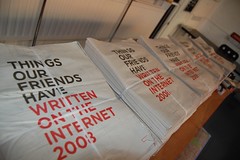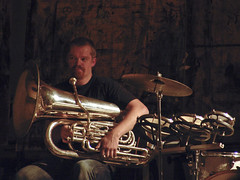A traditional creative setup: a team of 2.Traditionally a creative team within an advertising agency contents of two people: an art director and a copywriter. But this wasn't always the case. According to
Mark Tungate, in his book
AdLand, copywriters and art directors worked in different departments for long. My thought was that they didn't used to work in a team and maybe will not remain as such. There are several arguments for it to stay or to change. I myself am not quite sure what will, or would, work out best but I found it interesting to reflect on the topic.
Let me tell you why: Here, at
ProximityBBDO, we're working in teams made of 3 people. 3? 3... a copywriter, an (offline) art director: who specializes in one-on-one communication and an (online) art director: who specializes in online advertising, social media and broader technological applications.
Newly bride: teams of 3.Let me point out why
ProximityBBDO is running teams of 3 while most agencies are working teams of 2. First there's a structural problem on the level of education. There isn't really a training program for becoming a copywriter, in Belgium. Moreover, copywriters — writers that specialize in advertising — are increasingly scarce. An instant result of the lack of a decent copywriter education is that the creative inflow of fresh young talents consists of mostly art directors. Therefor a lot of agencies are 'forced' to work with teams of 2 art directors.
Business effectiveness brakes traditions.Next, when AtmosphereBBDO, DirectBBDO and ProximityBrussels merged — somewhere during the summer of 2007 — they became the countries largest integrated marketing company, housing a broad range of specialists that stretch from creative thinkers over flash- as well as backend-developers, on- and offline designers, direct response and web 2.0 specialists and CRM integrators. In the beginning there was clash. I can tell because I started there when the merging physically took place. For some people, in the beginning, it was horror. Gone was their safe and known — often narrow minded — world of safety that they had been known for so long. So to shorten that transitional period and reduce a fled of knowledge to other companies — as well as to limit internal conflict — the company needed to 'physically' merge these different profiles. Mixing the profiles would most likely (and it did, I can tell you already) ensure a fertile merge between very different company philosophies, spark the sharing of knowledge and eventually create cross-profiles that overlap various disciplines without being cost-intensive to the merger. Training a direct response specialist in social media could be proven very expensive if you'd send them all to some fancy community gatherings and expensive masterclasses. Also it was proven that shock therapy wasn't the key to solving the myriad of obstacles ahead. So, by integrating these different specialists into 1 team the skills for creating a full integrated marketing campaign are brought together. This way, working in teams of 3 could well be the glue for swapping knowledge, and the problem of scarcity of the copywriters would be solved (1 copywriter, more often than not, from a one-to-one background is bride with 2 art directors in order to make the circle complete).
A good blade always cuts twice.I can see you thinking about the downside of this set-up already, and of course every model — a solution to multiple problems in this case — has a downside.
For example, one extra person in every meeting is, as you would suspect, a heavy weight on the account/budget of every project. But, this cost is compensated with the fact that there's a saving post in the educational budget, as mentioned before.
The dark of a new model.A repercussion of working in this setup is that timings for creation shorten. Shorter timings put lots pressure on some projects — creation is
serendip-wise process as you all know of course — but again this has positive as well as negative outputs down the hammer.
Negative would be that some projects go out without thoroughly being thought of or with going for the idea at hand within one or two days... Another downside is that claiming ownership of 'you idea' becomes harder when you are working as an art director, especially when planning a career move (not that I'm planning one at the moment but still). When you claim ownership for the idea of a project the copywriter and art director are credited for 'their contribution' to the project. Other creatives and headhunters often refer to creatives as 'the art director who thought of or made that visual' of 'the copywriter who wrote that one line'. When working in team with 2 art directors that ownership becomes blurred to the outside world, but on the other hand an art director could as well I've come up with 'that one line' and vice versa.
The profit of discovery.The positive aspect of this timing push — for creatives — would be that there's an everyday training in efficiency and no time to just wander around and waste all that precious time. Another positive aspect of the setup — for the company — is that it is able to manage a bigger workload of projects and jobs, and the planning ease. Working in a tight schedule for time management makes it necessary to work with day-to-day plannings, parallel to like how lots of development and hotshop web companies work. Many more traditional ad-agencies don't keep pace with the tight schedule and plan in jobs and projects on a weekly basis, sometimes giving 3 to 4 briefings every week with different deadlines — I guess I mustn't mention that quite some creatives lack the discipline to keep pace with their agenda's. A tight day-to-day planning makes it easier to precisely measure the return on each specific job, which at it's turn makes it more ease to budget and plan feature projects and check down occurring issues. Of course, for the creative department, working in a day-to-day schedule puts the pressure on, every job.
I must also mention that working in this setup (teams of 3 creatives) never gets you cornered planning and assigning the briefings to the creative teams. As before the briefings would be carefully divided according to the knowledge and specialties of specific teams. This would corner you when all the sudden the market would flooded with online projects.
Hmmmm... (have a break, I had one as well)
Shape shifting profiles.Last thing I'd like to note is a more recent trend I've noticed, especially amongst some online creatives, is the doubt about the need of a creative team at all. Most art directors I know — the ones who are specialized in 'online' — are creatives with a more technological background. Moreover, lots of them started their careers as web designers or developers. And they're actually a weird species next to a traditional advertising creative, although also that is shifting vastly. The shift from being a web designer or developer — to being a creative thinker or concept maker — comes from the fact that they 'really' understand what is possible and what is not, and also because they can communicate with the back-office more easily. The latter is often a problem with 'traditional' creatives who push hard on the idea without understanding the technical and budget impact of it.
Drawing the wild card.These — the 'onliners' — are the species that don't often like to work in a fixed team. They're not used to working in a fixed team in the first place, as they most likely shift teamies regularly on various design and developing projects. Also they want to keep up with the pace of new media and technologies and are often best friends with their RSS readers. Explaining and sharing the enormous stream of information with their team members (the not tech savvy ones) is mostly time consuming, intensive and thus frustrating. In their opinions it slows development. Mostly they're more fond of working as a plug-and-play member. But of course handing out wild cards to some creatives with online skills isn't always an easily manageable position if the company is an oiled machine loaded with a large, and therefor strict, structure of departments and work flows.
The online creatives are more technical thinkers, spending lots time checking on flow models and usability. Often they incorporate interface ideas as an existential part of their concepts. The behavior of interaction is central, they are concerned about participation, they mostly understand the Groundswell better than most heads inside the office and think about more than just pushing and trying to add a pull. Many of them tend to shift towards a job described as "strategic planner" or to them in the more common position named "web strategist".
New ambitions.The ones shifting to the strategic positions found themselves working more in the support of the marketeers and accounts of the agency, as a sort of social media consultant or web guru housed in the creative department. These online creatives are sometimes more tech savvy and informed about current trends then others at the agency (mark the emphasize on sometimes :)) making them more skilled at observing consumer behavior as well as spotting attitudes of specific audiences. Also they gradually develop the ability to expose the tiniest niche into which a brand might squeeze.
The shift from being a creative to being a strategist springs — to my opinion — from the 'natural' fact online creatives stumble upon regularly. Namely, the combination of creative thinking with being strongly tech savvy often reverses the flow of input. This flow of input is traditionally: from client to account and strategist providing insight that starts a creative team down a certain path. If the creative — in this case the 'onliner' — has the feeling that more often than not he/she is providing or steering the input in a better direction then the ones who came up with the briefing did, well, then that creatives ambitions will start to shift eventually leading to the shift of working as a strategist. And being a strategist can be a very comfortable position, especially as a lot of traditional network agencies in Belgium (such as
LeoBurnett,
Publicis,
McCann,
Lowe,
Y&R, ...) haven't 'really' put their chariot on the right track (the full integration with online media and advertising) quite just yet. Traditional strategists often lack the knowledge of 'the unwritten tech specs', or just don't keep pace with the possibilities of new technologies. Shifting to work as strategist also it gives the the opportunity to escape the structure of working in team.
The reason why.Web strategists have become heroes in those (traditional) ad-agencies, especially the ones who have strong concept and thinking skills that can bride the creative departments with the developers and still distill and market a strategic and creative output that suits the needs of most clients.
So, I hope you've enjoyed this reflection and hope to hear from you anywhere soon.
Follow my blog with bloglovin





































